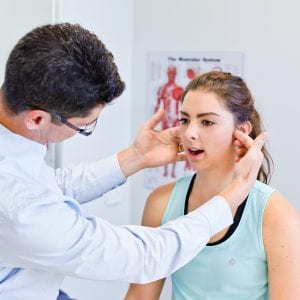Temporomandibular Disorder (TMD)
Article by John Miller
Temporomandibular Disorder (TMD)
What is Temporomandibular Joint Disorder (TMD)?
Temporomandibular Joint Disorder (TMD) affects the joint connecting your jaw to your skull, known as the temporomandibular joint (TMJ). This joint is essential for daily activities like chewing, speaking, and even breathing. When TMD develops, these functions can be compromised, leading to significant discomfort and disruption in everyday life (Gauer & Semidey, 2015).

Why Does TMD Occur?
Temporomandibular joint disorder arises from various causes, often a combination of biological, environmental, and psychological factors. These include injury to the jaw, arthritis, prolonged stress, or teeth grinding (Gauer & Semidey, 2015). TMD is not just a single condition but a group of disorders affecting the jaw’s muscles, joints, and nerves. Women between the ages of 20 and 40 are more commonly affected by TMD than men (LeResche, 1997; Sharma & Ohrbach, 2023).
How Does Temporomandibular Joint Disorder Present?
The symptoms of TMD can be quite varied. Common complaints include jaw pain, headaches, clicking or popping sounds when moving the jaw, and limited mouth opening (Durham, 2015; Shaffer et al., 2014). These symptoms might also extend to the neck and shoulders, making it essential to consider TMD in patients with such complaints. In some cases, TMD is linked to other conditions like chronic headaches, fibromyalgia, and sleep apnoea (Lim et al., 2010; Kleykamp et al., 2022).
What Causes TMD?
Temporomandibular joint disorder can result from various causes, including trauma to the jaw or head, arthritis, or stress leading to teeth grinding or clenching (Penlington et al., 2022). Poor posture, particularly from prolonged computer use, can also contribute to the development of TMD. Recognising these factors is key to effectively managing and preventing the progression of the disorder.
Investigating TMD: How is it Diagnosed?
Physiotherapists and dentists play a critical role in diagnosing TMD. A comprehensive assessment includes evaluating the jaw’s range of motion, palpating the muscles around the TMJ, and assessing the cervical spine (Ferran Cuenca-Martínez et al., 2020). Imaging studies, such as X-rays or MRIs, may be required to confirm the diagnosis and exclude other potential causes of jaw pain.
Treating TMD: What Are the Solutions?
Treatment for TMD is typically conservative. Physiotherapists use a multimodal approach that includes manual therapy, massage, therapeutic exercises, and patient education (Shaffer et al., 2014). Addressing contributing factors like stress and poor posture is also crucial. In some cases, the dental component of treatment is essential, particularly if teeth grinding or malocclusion (misalignment of teeth) is involved.
Read more: TMJ Physiotherapy Treatment
Dental Treatment for Temporomandibular Joint Disorder
Dentists play a key role in the management of TMD, especially when the condition is linked to dental issues like bruxism (teeth grinding) or bite misalignment. Dental treatments might include:
- Occlusal Splints (Mouthguards): These are custom-made devices worn at night to reduce the strain on the TMJ by preventing teeth grinding and clenching, which can alleviate pain and prevent further damage to the joint.
- Orthodontics: In cases where bite misalignment contributes to TMD, orthodontic treatment may be recommended to realign the teeth and jaws, reducing stress on the TMJ.
- Restorative Dental Work: Sometimes, restoring worn-down teeth with crowns or bridges can help balance the bite and reduce TMD symptoms.
- Botox Injections: Botox, known for its cosmetic uses, has also been shown to help relieve TMD symptoms by relaxing the muscles around the TMJ, thereby reducing pain and improving function. A study found that Botox injections can be an effective treatment for reducing muscle tension and pain in TMD patients (Blanco-Rueda, 2023).
Combining dental treatment with physiotherapy can provide a more comprehensive approach to managing TMD, addressing both the musculoskeletal and dental aspects of the condition.

FAQs about Temporomandibular Joint Disorder (TMD)
- Why does my jaw click when I open my mouth?
- This could be a sign of TMD. The clicking sound occurs when the disc inside the joint is not moving smoothly.
- How long does TMD last?
- The duration varies; for some, symptoms resolve in a few weeks, while others may experience chronic issues. Read more: TMJ Treatment.
- What are the main symptoms of TMD?
- Common symptoms include jaw pain, headaches, and restricted mouth opening.
- How is TMD diagnosed?
- Diagnosis involves a thorough clinical examination and sometimes imaging like X-rays or MRIs.
- Can stress cause TMD?
- Yes, stress is a significant factor in TMD, particularly through teeth grinding and clenching.
- Why is TMD more common in women?
- Hormonal differences and stress management styles may contribute to the higher prevalence in women.
- What treatments are available for TMD?
- Physiotherapy, stress management, and dental interventions like occlusal splints, Botox injections, or orthodontics are effective treatments.
- What should I do if my jaw locks?
- Seek immediate professional advice if your jaw locks, as this may require urgent care. Most dislocated jaws can be reloacted by a TMJ physiotherapist. Some will require manipulation under anaesthetic performed in ED or hospital.
- Is surgery necessary for TMD?
- Surgery is rarely required for TMD, as most cases respond well to conservative treatment, including physiotherapy and dental care.
- Can posture affect TMD?
- Poor posture, especially from prolonged sitting, can exacerbate TMD symptoms.
Latest Research on TMD
Recent studies have highlighted the importance of a biopsychosocial approach to managing TMD. For example, cognitive behavioural therapy has shown promise in reducing the pain associated with TMD, particularly in patients with comorbid psychological conditions (Penlington et al., 2022). A systematic review also suggests that addressing cervical spine issues can significantly improve TMD symptoms (De Oliveira-Souza et al., 2020). Additionally, dental treatments, such as occlusal splints and Botox injections, have been supported by research as effective in reducing symptoms related to bruxism and muscle tension in the TMJ (Blanco-Rueda, 2023).
What to Do?
If you suspect you have TMD, consult your physiotherapist or dentist. They can work together to assess your condition and create a tailored treatment plan to alleviate your symptoms and improve your quality of life.
Rochedale - Call 38410277
Book Online: RochedaleSalisbury - Call 32751044
Book Online: SalisburySandgate - Call 32691122
Book Online: SandgateRelated Articles
- TMJ FAQs – Discover answers to common questions about TMD, including symptoms and treatments.
- Jaw Pain – Learn about the various treatment options for TMD and how physiotherapy can help.
- TMD Treatment – Explore different methods to manage TMJ dysfunction effectively.
- What Causes TMJ? – Discusses the root causes of TMJ dysfunction and factors that contribute to this condition.
- Headache, Neck & Jaw – Understand the connection between TMJ issues and other physical discomforts like headaches and neck pain.
- TMJ Headache – Focuses on headaches resulting from TMJ disorders and offers insights into treatment options.
- Dry Needling for TMJ – Provides information on how dry needling can be an effective treatment for TMJ pain.
- TMJ Disorders – Offers a comprehensive overview of TMJ disorders, including symptoms and treatment options by the Mayo Clinic.
- TMJ Disorders Overview – A comprehensive overview of TMJ disorders, including symptoms and treatment strategies by Johns Hopkins Medicine.

Social Media
Follow us on our social media platforms for free tips on managing TMD and improving your jaw health. Stay informed with the latest advice and exercises to keep your jaw pain-free.









